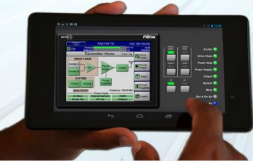Cost-Efficient: The GatesAir Flexiva FAX 20

[November 2019] Keeping costs under control is an important goal for any successful operation. Like many stations, KKRB has found its new solid-state transmitter offers significant cost efficiencies.
Wynne Broadcasting is a leading provider of radio news, talk, sports, and music to the more than 67,000 people that call the Klamath Basin home. From our studios in Klamath Falls, OR, our four FM stations, two AM stations, and two FM translators serve Southern Oregon as well as Northern California with 24/7 radio programming.
However recently, our tube transmitter which had reliably delivered our signal for KKRB since 1988 began showing signs that its end was near.
Signs It Was Time
Specifically, slight power bumps and other power fluctuations that are typical during our windy, snowy winters would occasionally knock the transmitter off the air.
I began receiving numerous automated alerts from our master control system, often sent in the middle of the night. I was able to quickly get that transmitter back on the air through remote control, but we clearly needed to start thinking about a more modern solution.
We were also ready to transition away from tubes and toward a high-efficiency solid-state solution. This would also reduce our maintenance overhead.
For example, a modern modular design would include hot-pluggable PA modules, power supplies, and fans that can be replaced without interrupting the on-sir signal.
The Flexiva FAX 20
Our solution was to install a new GatesAir Flexiva FAX 20kW air-cooled, solid-state FM transmitter at KKRB.
We purchased the equipment through SCMS Broadcast Equipment Solutions, which provided excellent service and support from start to finish.
We prepared for the arrival of our new transmitter by removing the old power supplies, exterior filters, and backup systems, all of which filled three adjacent equipment racks. These large, heavy systems were hauled away.
Immediate Space Savings
 The fully integrated FAX20 comprises a single equipment rack.
The fully integrated FAX20 comprises a single equipment rack.
With the Flexiva’s modular design and compact footprint – a remarkable 22 inches wide by 37.5 inches deep (and 83 inches high) – this transmitter has also freed up valuable space inside in the once-crowded transmitter building, making it easier for our engineers to move about and do their work.
Installation and set-up went very smoothly: the crew bolted the new transmitter into place, inserted the power modules, connected the wires, and fitted some hard lines running to the transmitter.
While this seems modest on paper, it is important to emphasize how liberating it is from a labor perspective. It had long been a challenge for engineers to work on the transmitters and gain access to the rear.
Additionally, this allowed us to add a workbench for our engineers to more easily manage tools and manuals as they work.
A Good Fit
While we did consider a liquid-cooled model, we stayed with an air-cooled system as we were comfortable and familiar with that technology.
The architecture also made sense for us because our HVAC system was already set-up for aircooled transmission. We capture heat emanating from the top of the transmitters and vent it directly outside. As a result, the only modification we needed to make during installation was to adjust the position of the HVAC hood over the new transmitter once it was in place.
Rapid Benefits
So, with this installation, and other modifications we made, it did not take long to see the benefits – including a substantial savings on our electric bill thanks to a much higher efficiency platform, 72% from AC to RF.
The modern high-efficiency air-cooled system has clearly delivered in the early days. The older system was producing too much heat, and it was a challenge to sufficiently cool our room. This meant a reliance on air conditioning systems that in the end were not providing much value.
Now we can better manage the heat load to the room, even though we have four transmitters, two exciters, and two new translators operating in this building.
Looking Ahead With Confidence
We are gratified to know that if something were ever to fail on the new Flexiva, it is designed to continue broadcasting, albeit at a reduced power level that is not noticeable through most of market.
That buys us time to get a maintenance crew and spare parts to the transmitter site for repairs.
In fact, there are many redundant failover and enhanced performance features of the FAX20 that help deliver better service to our audience, including an IP-enabled web remote interface with SNMP protocol to simplify remote monitoring and control.

An Upgrade That Works
Along with the transmitter’s energy-efficient architecture, the ability to keep the transmitter building cooler, even on hot summer days, will save us considerably on electric bills over time. And with transmitter emergencies a thing of the past, what price can you put on being able to sleep soundly through the night with no station alarm bells ringing?
GatesAir designed the Flexiva FAX to lower the total cost of ownership for radio broadcasters like us by providing high-energy efficiency, ease of maintenance, and reliable operation.
Since we have installed it, the FAX20 has lived up to its reputation. The built-in FAX exciter provides a stable amplified signal, and our signal is stronger and clearer throughout the market.
The entire system is also HD Radio-ready should we adopt that technology in the future.
We could not be more pleased with our improved over-the-air service, reduced utility bills, streamlined maintenance, and newfound peace of mind.
– – –
More information on the Flexiva FAX series is available here.
– – –
Robert Wynne is the President & CEO of Wynne Broadcasting. Contact him at: bob@klamathradio.com
